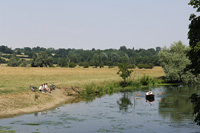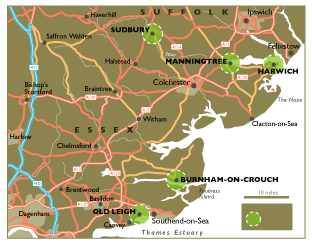- Details
- Written by: Active Traveller Staff
Country Brakes
Did you know that Colchester is Britain’s oldest recorded town, dating back to 77AD, before the Roman conquest? Or that the mountain biking at the 2012 Olympics will take place at Hadleigh Farm, in south Essex? Or that the pier at Southend is the longest in the world? Probably not, but that’s what makes Essex ripe for exploration, and there’s no better way to explore than by bicycle.
It is also a county of contrasts. Estuaries and coastal villages steeped in maritime tradition in the east, give way to rolling fields, ancient woodlands and beautiful parks as you head inland. There’s a notable lack of punishing hills in this part of eastern England, but an abundance of byways, bridleways and country lanes, making it ideal cycle country. So saddle up, and follow our guide to some of the best cycling Essex has to offer.
The painters’ trail
Beginning at either Manningtree, Essex or Sudbury, Suffolk, the Painters’ Trail is a circular route ideal for cycling through some of the county’s most celebrated and picturesque countryside. The full trail runs over roads, cycle paths and tracks and can be covered in two to three days, with a total distance of 111km (69 miles), but there are various shortcuts available for morning, afternoon or full-day rides. Part of National Cycle Route 1, it is ideal for both the experienced and part-time cyclist.
One of Britain’s most famous artists, Constable, lived and painted in a rural area on the border between Essex and Suffolk. The Dedham Vale, in the Stour Valley, is now a designated Area of Outstanding Natural Beauty and forms the centre point of this great cycle adventure. The Painters’ Trail links Constable Country with areas made famous by other celebrated British artists, including Gainsborough and Munnings.
Your two-wheel art history pilgrimage begins at England’s smallest market town, Manningtree, which nestles on the south bank of the River Stour. From here, head to Cattawade and its nationally protected marshes (home to waterfowl and waders), where the freshwater Stour meets the tidal estuary. You’ll reach the lowest point of your entire journey on the way, at two metres above sea level.
The route from Cattawade suddenly thrusts deep into the heart of Constable Country. It’s worth taking a break in the attractive villages of East Bergholt and Flatford, both steeped in the artist’s history. John Constable was born and grew up in East Bergholt House, parts of which still exist, and Moss Cottage was used by him as a studio. Bridge Cottage in Flatford has a Constable exhibition, and the surrounding area is where several of his major works are set, including Boat-Building near Flatford Mill and The Hay Wain. Flatford Mill itself was once owned by Constable’s father and is now a National Trust building. There’s so much to see here it may be worth a ‘refreshment stop’ at one of East Bergholt’s many pubs, of which The Hay Wain is probably the most appropriate.
The route then provides an opportunity to really stretch the legs as it meanders past and through a number of villages and hamlets, including Holton St Mary, Lower Raydon, Shelley and Thorington Street, from where a shortcut is available, cutting the total distance back to Manningtree to a ‘manageable in one day’ 37km. After Thorington Street comes Stoke-by-Nayland, situated on a ridge between the Stour and Box valleys, where you’ll find the 15th-century St Mary’s Church and its 40m-high tower.
Continued...
 From Stoke-by-Nayland, head north to Polstead, famous for its cherries and the ‘Murder in the Red Barn’, an infamous 19th-century crime of passion. After negotiating its steep main street, turn back in a southerly direction for about six kilometres, passing through the pretty village of Nayland, a former weaving centre, then the hamlet of Wissington. Another short-cut opportunity (making the total journey 64km) presents itself just after Wissington as the route meets itself coming the other way, then turns sharply north before cutting through Arger Fen, a remnant of the ancient wildwood that covered Suffolk some 1,000 years ago. Next door, Spouse’s
From Stoke-by-Nayland, head north to Polstead, famous for its cherries and the ‘Murder in the Red Barn’, an infamous 19th-century crime of passion. After negotiating its steep main street, turn back in a southerly direction for about six kilometres, passing through the pretty village of Nayland, a former weaving centre, then the hamlet of Wissington. Another short-cut opportunity (making the total journey 64km) presents itself just after Wissington as the route meets itself coming the other way, then turns sharply north before cutting through Arger Fen, a remnant of the ancient wildwood that covered Suffolk some 1,000 years ago. Next door, Spouse’s
Vale is a tapestry of fen meadow and woodland, the perfect spot for a picnic.
Roughly 7km on sees the route pass through Little Cornard and then the larger village of Great Cornard, which was painted by Thomas Gainsborough. Attractions here include nature reserve Cornard Mere, and Great Cornard Country Park, which contains wildflower meadows and woodland.
Sudbury itself is the largest conurbation you will pass through, its wide variety of pubs and accommodation making it a sensible choice for overnight rest. Birthplace of Gainsborough, this ancient market town on the banks of The Stour is a veritable shrine to the artist and Gainsborough House displays more of his work than any other gallery outside of London. As you travel north from Sudbury towards Long Melford, Suffolk’s ‘antiques capital’ and the furthest point from the start of your journey, it’s possible to take a slight detour off-route to Lavenham (about 5km away), England’s best-preserved medieval town.
Another lunch spot en route is Rodbridge Picnic Site, a wildlife habitat created around some flooded gravel pits. After skirting the edge of Sudbury once more, the cycling again gets more rural as you cruise down country lanes to Bulmer, before changing direction back southeast through gently rolling countryside to the villages of Bulmer Tye and Great Henny.
From Great Henny head through Henny Street hamlet and Lamarsh to Bures, once a major malting centre, which consists of Bures Hamlet in Essex and Bures St Mary in Suffolk. Several country pubs make this large village another good spot for some R&R (rest and real ale).
Your revitalised legs should propel you comfortably through the village of Little Horkesley and the scattered rural parish of Boxted before reaching the next point of artistic interest, Langham village. It was here that Constable painted Glebe Farm, and at the wooded St Mary’s Church where he met in secret his bride-to-be Maria Bicknell. He also painted Dedham Vale from the tower.
After passing through Stratford St Mary, you’ll be on the home stretch, but it’s worth pausing at Dedham, a former wool town, for its rich history. St Mary the Virgin Church appears in many Constable works, including The Risen Christ, and don’t miss the Sir Alfred Munnings Art Museum, where the artist lived and painted for 40 years. If you have children in tow, it’s also worth popping into the Dedham Art and Craft Centre, which houses a toy museum. From here, Flatford is a worthy 2km detour (by foot), across the very meadows where Constable sketched.
By this time you should be able to smell the end of your epic journey, passing through Lawford before finishing back at Manningtree with a satisfying burn in the thighs and the country air circulating your lungs. Happy cycling!
Continued...
The Witchfinder’s Way
Starting point: Harwich
Length: 41km (26 miles), shortcut to 34km available
Route type: Circular, on roads and cycle paths, one day
Back in the 17th century Matthew Hopkins was known as ‘The Witchfinder General’, employed to hunt the witches of the area. This day-long cycle ride winds through charming villages and rolling countryside to picturesque port and The Witchfinder’s old haunt, Mistley, on the River Stour. The route then turns back to follow the Stour Estuary, through riverside hamlets and the RSPB Stour Estuary Nature Reserve, famed for its saltmarsh and mudflat habitats, before passing through the attractive village of Ramsey and ending back at Harwich.
Two Rivers’ Way
Starting point: Burnham-on-Crouch
Length: 40km (25 miles), shortcut to 19km available
Route type: Circular, on roads, one day
Situated in the Crouch Estuary, unspoiled Burnham-on-Crouch is one of England’s premier yachting centres and the starting point for a nature-lover’s cycle tour. The route explores the Dengie Peninsula, where you’ll find weather-boarded villages, small sailing hamlets and, most importantly, an abundance of saltmarshes, home to several important bird-nesting sites. En route, there is also the opportunity to take a ride on a working steam locomotive and visit a Saxon church before indulging in some local oysters back at Burnham.
Essential Estuary Trail
Starting point: Old Leigh
Finishing point: Shoebury Common
Length: 10km (6 miles)
Route type: One-way, mostly flat, a few hours (with stop-offs)
This route follows the estuary promenade, a leisurely way to enjoy Southend’s spectacular coastline, beginning in the quaint cobbled fishing town of Old Leigh. Breathe in the sea air as you cycle through Chalkwell, Westcliff, central Southend and finally Shoebury, with plenty of distractions along the way. Of course, this seaside sojourn wouldn’t be complete without an ice cream on the pier at Southend, at 2,158m the longest pier in the world.
Credit of Images: IMAGE: Essex Tourist Board, MAP: John Plumer




